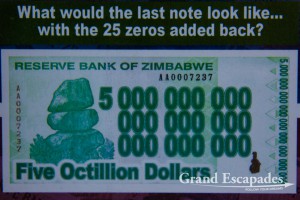 Once the bread basket of southern Africa and a country with a flourishing tourism industry, the economy of Zimbabwe collapsed between 1998 and 2009. Hyperinflation forced people to shop for bread with 100 Trillion Zimbabwean Dollar bills, the price tags in supermarkets could not be exchanged fast enough. Not to mention the massive shortage of almost all staple goods. Reasons for this disaster were manifold, but the widest international media coverage received Mugabe expelling white farmers and distributing the land to his cronies. Local farmers gained next to nothing from so these called “land reforms”, and actually the country’s black population suffered the most. When agricultural production dropped at an alarming pace and tourism came to a standstill, Mugabe started the printing press. In 10 years, the reserve bank cancelled 25 (!!!) zeros on bank notes.
Once the bread basket of southern Africa and a country with a flourishing tourism industry, the economy of Zimbabwe collapsed between 1998 and 2009. Hyperinflation forced people to shop for bread with 100 Trillion Zimbabwean Dollar bills, the price tags in supermarkets could not be exchanged fast enough. Not to mention the massive shortage of almost all staple goods. Reasons for this disaster were manifold, but the widest international media coverage received Mugabe expelling white farmers and distributing the land to his cronies. Local farmers gained next to nothing from so these called “land reforms”, and actually the country’s black population suffered the most. When agricultural production dropped at an alarming pace and tourism came to a standstill, Mugabe started the printing press. In 10 years, the reserve bank cancelled 25 (!!!) zeros on bank notes.
After the 2009 election, which the opposition actually won, but with Mugabe unwilling to step down, a new power sharing government allowed using the US Dollar or the South African Rand. Quickly, the economy stabilized.
Today, Zimbabwean Dollar bills are a popular souvenir sold all over Victoria Falls. At first, we thought that they were fake, but quickly realized it would be way too expensive to copy bills that are worth nothing. Moreover, several sellers told us frankly that they would buy them from the banks.
 So we did not know what to expect travelling to such a country. At first sight, the economy has recovered at light speed: roads are in excellent state, mobile phones are everywhere, American-style supermarkets blanket the country and fuel is readily available. What remained unanswered was how people, who often earn less than 200 USD a month, can afford to pay the prices that come close to those in Europe or the USA…
So we did not know what to expect travelling to such a country. At first sight, the economy has recovered at light speed: roads are in excellent state, mobile phones are everywhere, American-style supermarkets blanket the country and fuel is readily available. What remained unanswered was how people, who often earn less than 200 USD a month, can afford to pay the prices that come close to those in Europe or the USA…
One thing we immediately noticed was how thinly populated the country is: some rural areas seem completely unpopulated and even in bigger cities, there is none of the bustling found in other African towns, no traffic jams, no shoving street vendors. Estimates suggest that the country has lost a third of its population over the last ten year, due to mass emigration and AIDS: currently, an estimated 8 to 10 million people live in Zimbabwe, against 14 million before the crisis.

No comments yet.